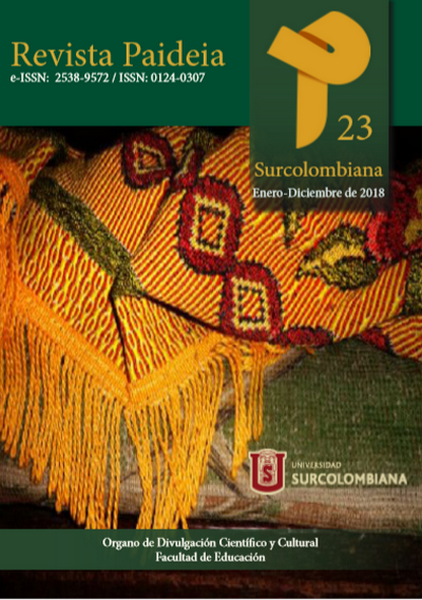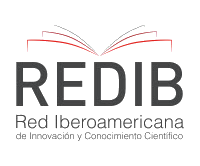Sound environments of learning: a didactic strategy that promotes environmental education
##plugins.themes.bootstrap3.article.main##
The present paper gathers an experience of applied environmental education in the courses of history of the contemporary music, history of the colombian art and didactics of the music, the first two pertaining to the degree in artistic and cultural education and the last one to the degree in education child of the Surcolombiana University. The research aims, on the one hand, to sensitize students about the environmental crisis derived from the current development model, as well as the causes that have caused it. In the same way, it seeks to implement in the classroom the didactic strategy called Sound Environments of Learning (SEL) as a pedagogical alternative that focuses on the Geopoetics of Living, as it links the classroom with the understanding of the cultural and ecosystem environments in relation to the individual and collective writings that human beings do on the planet. The methodology implemented is of a qualitative type with a descriptive focus, contemplating the development of six phases through which the meeting of the three groups of students where one of these is responsible for preparing the SEL sample is encouraged. The results obtained show a definition of Sound Environments of Learning, likewise, the way in which the activities were carried out, the contributions that provide to the formation of the students, and finally the learning achieved manifested by the surveyed student body.
Downloads
##plugins.themes.bootstrap3.article.details##
Angel-maya, A (1995) La fragilidad ambiental de la cultura. Bogotá: IDEA – UN.
Ángel-Maya, A. (2013) El Reto de la Vida. Publicación en línea https://webcache.googleusercontent.com/search?q=cache:dfdWblWIasUJ:https://rds.org.co/apc-aa-files/ba03645a7c069b5ed406f13122a61c07/el_reto_de_la_vida.pdf+&cd=1&hl=es&ct=clnk&gl=co.
Bauman y Mazzeo (2013). Sobre la Educación en un mundo líquido. Barcelona, España: Paidós.
Ballester y Colom (2017). Epistemologías de la complejidad y educación. Barcelona, España: Editorial Octaedro.
Cova y Svanfeldt (1992) Societal innovations and the postmodern aestheticization of everyday life. Recuperado de https://www.researchgate.net/publication/256431763_Societal_innovations_and_the_postmodern_aestheticization_of_everyday_life.
Delgado et al. (2013). Crisis Socioambiental y Cambio Climático. Buenos Aires, Argentina: CLACSO.
Fernández D. y Quintana H. (2002). Anotaciones Filosófico-musicales a propósito de Pierrot Lunaire de Arnold Schonberg. Boletín Millares Carlo. Recuperado de http://mdc.ulpgc.es/cdm/ref/collection/bolmc/id/320
Fischer-Kowalski y Haberl (2000). El Metabolismo Socioeconómico.Departamento de Ecología Social del Interdisciplinary Institute of Research and Continuing Education (IFF) recuperado de https://es.scribd.com/document/281530189/El-Metabolismo-Socioeconomico-Fischer-y-Kowalski
Freire, P. (1985). Pedagogía del Oprimido. Montevideo, Tierra Nueva: Siglo XXI Editores.
Fuenmayor, V. (1999). El Cuerpo de la Obra. Universidad del Zulia. Maracaibo, Venezuela. Recuperado de https://es.scribd.com/document/247508812/Cuerpo-de-La-Obra-1-de-Victor-Fuenmayor
Gadotti, M (2003) Perspectivas actuales de la educación. Buenos Aires, Argentina: Siglo XXI Editores. Recuperado de https://issuu.com/mazzymazzy/docs/perspectivas_actuales_de_la_educaci
Guerrero, P. (2002). La Cultura, Estrategias conceptuales para entender la identidad, la diversidad, la alteridad y la diferencia. Escuela de Antropología Aplicada. Quito, Ecuador; Ediciones Abya-Yala.
Heidegger, M. (1994). Conferencias y Artículos. Eustaquio Barjau (traducción). Madrid, España: Ediciones del Serba.
Hinkelammert, F. (2006). Prometeo, el discernimiento de los dioses y la ética del sujeto. Recuperado de https://journals.openedition.org/polis/5527
Ivaldi, E. (2013). El Arte de los ruidos. Revista Que hacer Educativo. Recuperado de http://webcache.googleusercontent.com/search?q=cache:249qQgaRZAgJ:www.fumtep.edu.uy/index.php/component/k2/item/download/904_ed4ea3479dbf64e3c08cbb1aa76a2e4e+&cd=10&hl=es&ct=clnk&gl=co
Lasso, A. (2017). Análisis hacia la interpretación de la Danza del Sacrificio en La Consagración de la Primavera de Igor Stravinsky. Recuperado de http://bdigital.unal.edu.co/57359/7/AlexanderLassoRubio.2017.pdf
Maffesoli, M. (1992). La transfiguración de lo político: la trivialización del mundo postmoderno. Editorial Herder.
McLaren, P. (1998). Multiculturalismo Revolucionario. Siglo XXI Editores. http://funama.org/data/PEDAGOGIA%20CRITICA/mclaren/Multiculturalismo%20Revolucionario.pdf
Noguera, A.P. (2000) Educación Estética y Complejidad Ambiental. Universidad Nacional de Colombia. Sede Manizales. Recuperado el 6 de octubre de 2016 http://www.bdigital.unal.edu.co/7076/1/anapatricianogueradeecheverri.2000.pdf
Noguera, A. P. (2004). El Reencantamiento del Mundo. Universidad Nacional de Colombia. Sede Manizales. Recuperado el 6 de octubre de 2016 http://www.bdigital.unal.edu.co/5963/2/9687913312.pdf
Noguera, A.P. (2012). Crisis Ambiental: Pérdida del Cuerpo y de la Tierra. Recuperado el 8 de septiembre de 2017 http://vip.ucaldas.edu.co/culturaydroga/downloads/Culturaydroga17(19)_12.pdf
Noguera, A. (2014). Geopoética del habitar sur. Recuperado de http://www.sustentabilidades.usach.cl/sites/sustentable/files/paginas/05_0.pdf
OCDE (2014). ¿El arte por el arte? Centro para la Investigación e Innovación Educativas. Recuperado de https://www.oecd.org/edu/ceri/ES_ARTS_overview_V5_print.pdf
Pineda, J. (2014). Geopoética de la guerra: he oído música en el estruendo del combate y he hallado paz donde las bombas escupían fuego. Recuperado de http://studylib.es/doc/7867800/geopo%C3%A9tica-de-la-guerra---he-o%C3%ADdo-m%C3%BAsica-en-el
Romano, A. (s/f). Homenaje a la precursora de la música electroacústica en Colombia: Jacqueline Nova Sondag. Recuperado de http://www.mincultura.gov.co/prensa/noticias/Paginas/Homenaje-a-la-precursora-de-la-musica-electroacustica-en-Colombia-Jacqueline-Nova-Sondag.aspx
Ruiz, J. et al (2009). Microdiseño del curso Historia del Arte Contemporáneo. Licenciatura en Educación Artística y Cultural. Universidad Surcolombiana.
Serres, M. (1991) El Contrato Natural. Paris: Pre-Textos.
Steiner, G.(1991) En el Castillo de Barba Azul. Aproximaciones a un nuevo concepto de Cultura. Barcelona: Gedisa.














